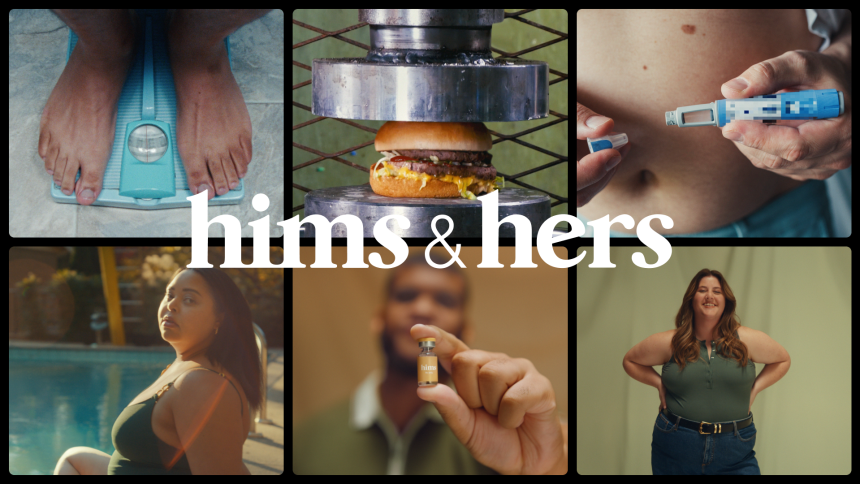The crack and fizz of a freshly opened bottle of Mountain Dew. Matthew McConaughey wielding a fried chicken wing like a baton. Reese’s Peanut Butter Cups, so decadent and oozing with chocolate that they’re driving people to risk self-immolation at the foot of a volcano.
This year’s Super Bowl Sunday was a typical junk-food bacchanal. That is, until one ad may have cast that second helping of buffalo dip in a different light.
In the third quarter of the game, the DTC telehealth company Hims & Hers ran a PSA-style ad highlighting America’s obesity epidemic, complete with shots of jiggling bellies, spinning scales, eerie medical scans, and a message that “obesity leads to half a million deaths each year.”
“Something’s broken, and it’s not our bodies,” the ad warns viewers, before offering a solution: weight-loss drugs, like semaglutide, which Hims & Hers sells in a compounded form.
The commercial, set to Childish Gambino’s “This is America,” was the only national broadcast mention of semaglutide, the main ingredient in some so-called miracle weight-loss drugs that have exploded in popularity in recent years, but its presence in the game represented a stark reminder of the still-to-be-seen effects on the segment of the food and beverage industry that could simply be categorized as junk food. According to a KFF survey taken last year, 1 in 8 adults have used GLP-1 drugs, and by 2033, the market is expected to balloon to $150 billion, according to an estimate from BMO Capital Markets. Executives at companies like Walmart have acknowledged the business impacts as consumers using the drugs buy and eat less food.
“That spot, I think, in many respects, represents a real warning shot to the legacy traditional food and beverage industry that is spending…millions upon millions of dollars at the Super Bowl,” said Sam Hornsby, the founder and CEO of Triptk and an executive team member of Havas’s GLP-1 consultancy.
“This is America”
Establishing a juxtaposition against the indulgences of Super Bowl Sunday, a day where some 12.5 million pizzas are ordered, was very much intentional for an appearance that could be audiences’ introduction to the brand, Dan Kenger, chief design officer at Hims & Hers, told Marketing Brew.
The brand leaned on archival footage and a documentary-style aesthetic to stand out among what Kenger described as the “monster productions” of other advertisers.
“I can’t compete with Doritos; I can’t compete with Geico,” he said. “We wanted to fight our own fight, and we felt like we could do that by taking this type of approach to stand out.”
Him & Hers is planning to continue running the campaign after the Super Bowl, Kenger said. It’s got stiff competition. Though it didn’t appear on Sunday, Novo Nordisk, the maker of semaglutide drugs Ozempic and Wegovy, spent $392 million advertising those brands on linear TV in 2024, according to iSpot. Eli Lilly, the maker of the tirzepatide drugs Mounjaro and Zepbound, aired two ads during the Golden Globes in January, and on Sunday night’s livestream of the game on Tubi, telehealth company Ro promoted a GLP-1 weight-loss drug from Eli Lilly that is available through its platform, although the ad didn’t run in the linear broadcast.
Get marketing news you’ll actually want to read
Marketing Brew informs marketing pros of the latest on brand strategy, social media, and ad tech via our weekday newsletter, virtual events, marketing conferences, and digital guides.
The business of compounded weight-loss drugs can be complex. Non-generic drugs listed by the FDA as being in shortage can be compounded, whereas those that are not listed as being in shortage cannot. In the spot, Hims & Hers, which offers compounded semaglutide, takes a shot at Big Pharma with a voiceover saying that “there are medications that work, but they’re priced for profits, not patients.” The FDA has issued warnings about compounded GLP-1s, which are not FDA-approved.
Ahead of the game, some lawmakers and advocacy groups pushed for Him & Hers’s ad to be pulled, claiming that it could be “misleading patients” because the ad does not disclose potential side effects.
The GLP-1 Bowl?
So far, the arrival of GLP-1s hasn’t changed ad creative from food and beverage advertisers during the big game, said Chloé Depiesse, EVP, head of digital strategy at Havas Health & Creative’s Innovation Hub and a lead at Havas’s GLP-1 consultancy.
“I don’t think this year there’ll be anybody perhaps bold enough to address the subject of GLP-1s,” she told us. But with increased adoption, “I can totally see this changing next year.”
Change is already coming to grocery-store shelves. Last year, Nestlé announced a line of frozen meals called Vital Pursuit, intended to be eaten as a “companion” to GLP-1 weight-loss drugs; Conagra has released a similar line. And juice chain Smoothie King rolled out a line of drinks marketed as a “GLP-1 support menu.” Abbott unveiled a protein shake brand to “capitalize on the surge of demand for the drugs,” Reuters reported.
Depiesse said there is a trend toward health-consciousness in food and beverage marketing, including emphasizing nutrition and lifestyle, but noted that even health-conscious brands won’t entirely replace some of those Super Bowl favorites.
“There will always be, I think, a place for the pizzas of the world,” she said.
Read the full article here










